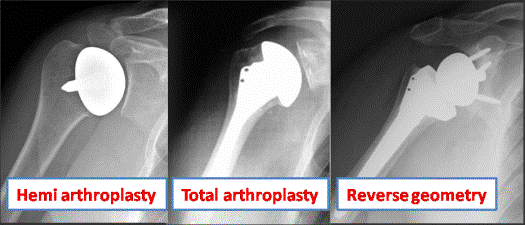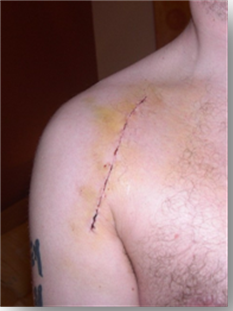Shoulder Arthritis
 Arthritis or degenerative joint disease of the shoulder occurs when the cartilage gets worn away. The joint develops spurs and the surface becomes irregular. In the end all the cartilage is gone and the two bones in the joint rub against each other causing debilitating pain and stiffness.
Arthritis or degenerative joint disease of the shoulder occurs when the cartilage gets worn away. The joint develops spurs and the surface becomes irregular. In the end all the cartilage is gone and the two bones in the joint rub against each other causing debilitating pain and stiffness.
Why have I got shoulder arthritis?
Shoulder arthritis can be due to wear and tear and be part of a generalised arthritis in the hips and knees; this is called primary arthritis. Rheumatoid arthritis is a common cause or an injury to the shoulder joint which has left the joint uneven.
What are the non operative treatment options?
When the shoulder is badly worn out, a shoulder replacement is effective at relieving the pain and will increase the amount of movement in the shoulder. However before resorting to surgery all non operative measures should be exhausted. Initially painkillers and modification of activities are helpful. Physiotherapy in the early stages will delay the onset and extent of any stiffness.
If the pain continues then steroid injection may reduce the pain caused by any inflammation in the joint. Injections of hyaluronan may be beneficial, which is also called viscosupplementation. A course of injections into the joint supplement the viscosity of the joint fluid, thereby lubricating the joint, has cushioning properties, and produces an analgesic effect. Hyaluronan may also have a positive biochemical effects on cartilage cells. However, studies have cast doubt on the long term efficacy of hyaluronan injections, and are therefore only recommended as the last alternative to surgery.
What are the surgical options?
Joint Replacement also known as an arthroplasty (see video -Total shoulder replacement) The shoulder replacement is an artificial joint which is made of metal and plastic. Arthritis affects every patient differently and there are several different types of joint replacement. The correct choice of implant is essential for a good outcome and you should discuss this with your surgeon.

The hemi arthroplasty- The surface of the joint is replaced with a smooth metal head and the other side of the joint is left alone. This is the least invasive option and is the most commonly performed arthroplasty.
The total shoulder replacement- if the cartilage and bone on the socket (glenoid) side of the joint is also badly worn; a plastic polyethylene tray is used to resurface it and this articulates with the metal head. It gives a better range of movement than the hemi arthroplasty but over 10-20 years the plastic wears away and complex revision may become necessary.
The Reverse geometry- the above operations require good muscle function around the shoulder to work properly. In some patients the muscles of the rotator cuff are damaged; if this is the case a reverse geometry shoulder replacement can restore excellent function in what would otherwise be a useless, painful shoulder.
What should I expect after the operation?
 The anaesthetist will have used an anaesthetic block to make the arm numb during surgery and the immediate post operative period. Once the numbness has worn off (4-8 hours) the shoulder will become painful and you will be given regular pain killers as soon as you get back to the ward. Even though you may be pain free at rest you must take the tablets for when you move the shoulder as part of your rehabilitation program.
The anaesthetist will have used an anaesthetic block to make the arm numb during surgery and the immediate post operative period. Once the numbness has worn off (4-8 hours) the shoulder will become painful and you will be given regular pain killers as soon as you get back to the ward. Even though you may be pain free at rest you must take the tablets for when you move the shoulder as part of your rehabilitation program.
A combination of regular painkillers such as paracetamol or codeine should be taken with NSAIDs (unless contra-indicated) such as ibuprofen- which is also an anti inflammatory drug. If the pain killers you have been given are not sufficient please contact your consultant's secretary or your GP.
The procedure is an open operation through a 12- 20 cm incision and is closed with a dissolving stitch. This heals well, usually leaving a faint scar. The dressing should remain on for 10- 14 days, kept clean and dry until it is removed at your follow up appointment. If you have any concerns about the wound you should contact your surgeon's secretary or your GP practice nurse.
You will be given a sling which will protect your shoulder and should be worn for a minimum of 3 weeks. You will need a dedicated physiotherapy program after your surgery. If you have been seeing a physiotherapist prior to your surgery (who may have referred you to Guildford Upper Limb), you should arrange to see them afterwards so you can start your rehabilitation straight away. If you do not have a physiotherapist we can arrange one for you.
Is there anything that can go wrong?
Shoulder joint replacements are very successful and most people who have them are delighted with the operation and are glad they had it done. Like any operation a very small number of people can have a problem. The main problems with the shoulder are infection, loosening of the replaced parts or fracture of the hone during the operation. Nerves can be bruised and the shoulder can become stiff. The risks of these problems only add up to 2-3% of all operations but need to be taken into account when deciding whether to have the operation. You should discuss the possibility of problems with your surgeon before your operation.
When can I return to driving and work?
You will not be able to return to driving for 6 weeks.
You can return to a sedentary job such as office work at 3 weeks, most patients return to light manual work at 6 weeks and heavy labour at 8-10 weeks. Because the tendon has to heal down to the bone the physiotherapy regime is designed to give maximum range of motion without putting the repair at risk.
As a guide swimming freestyle is 3 months but breast stroke at 6 weeks, golf and contact sports 3 months.



